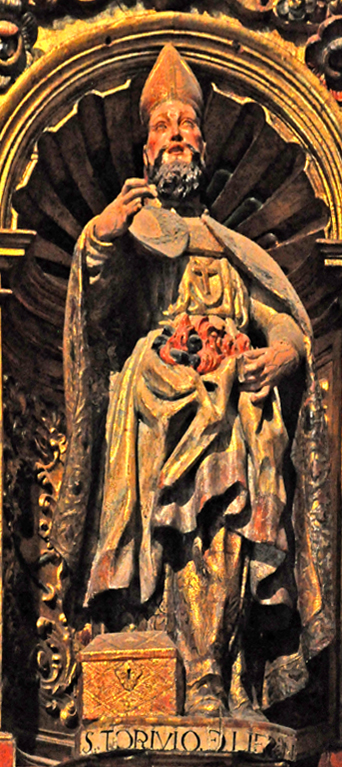
José Bernardo de la Meana
St. Turibius of Astorga
1747
Cathedral of San Salvador, Oviedo, Spain
This saint was bishop of Astorga, Spain, in the 5th century. He vigorously promoted ecclesiastical reform and opposed Priscillianism, a belief system related to Gnostic and Manichean dualism. His feast day is April 16.1
In the statue shown here, the chest refers to the Arca Santa, a reliquary on display in a special chamber in the cathedral. According to a 13th-century vita, St. Turibius acquired relics "of Our Lord Jesus Christ and many other saints" while on pilgrimage in Jerusalem. Later he delivered them in a locked chest to King Alfonso, who built a church for the relics dedicated to "the Holy Savior" (the name of the present cathedral). The vita adds that the king then made Turibius Bishop of Astorga. Excerpts from the vita are presented below. The account is almost entirely false,2 but obviously our sculptor found it convincing.
In the statue, the bishop holds flaming coals in a fold of his
rochet.
a white vestment worn by bishops and abbots when officiating at services other than the Mass
These refer to an episode in another vita: An archdeacon resentful of the bishop's reforms accused him of adultery. To demonstrate his innocence, Turibius walked the entire ambit of the church while holding flaming coals in a fold of his rochet. As he walked, he recited Psalm 67 ("Let God arise, and let his enemies be scattered"). When he finished, the rochet was seen to be unharmed and immaculate as ever.3
The inscription on the pedestal of the statue incorrectly identifies the saint as Turibius of Liébana, a monk who lived in the following century.
Photographed at the cathedral by Richard Stracke, shared under Attribution-NonCommercial-ShareAlike license.
TURIBIUS AND THE CHEST OF RELICS
[Turibius] went to Jerusalem with some companions. At that time there was bitter warfare in Jerusalem and the territory around it between the Moors and Christians. Blessed Turibius, seeing sacred vessels being stolen and church property destroyed, took only the relics of Our Lord Jesus Christ and many other saints (not wanting to take anything else) and carefully hid them in his baggage. When he wanted to go back to his country [Lombardy], things happened not as he had planned. For God guided the ship until it landed at the port known as Beges, the port of Oviedo. The holy man, wanting to lead a solitary life and not a worldly one, went up a mountain called Mons Sacer, and in honor of the holy virgin Mary built an oratory there. He put his relics in a chest.…
At that time hunters of King Alfonso came to these mountains with their dogs and snares in search of game. When they came to the place where the relics were hidden, they did not find anyone and they wanted to open the chest. But they could not, the chest staying closed by the will of God, for it was under the care of the blessed man. The hunters went back to the king and told him what they had seen. The king entreated him [Turibius] to come to Oviedo. Persuaded at last, the holy confessor of God went there and gave the king the relics of the Holy Savior, in whose honor the king built the marvelous Church of San Salvador in Oviedo. At that time the Bishop of Astorgas died and King Alfonso (called "the Chaste" for his chastity and sanctity) assigned Turibius to that episcopacy.
Translated from chapters 3 and 4 (pp. 39-40) of the Istoria S. Thuribii, in Baudouin de Gaiffier, "Vie et Miracles de S. Turibius," Analecta Bollandiana, 59 (1941), 38-64.
NOTES
1 Butler, II, 101.
2 Baudouin de Gaiffier, "Vie et Miracles de S. Turibius," Analecta Bollandiana, 59 (1941), 35-37.
3 Acta Sanctorum, April vol. 2, 423; October vol. 13, 228.